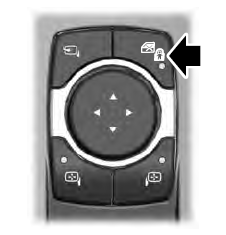Lincoln Aviator: Handles, Locks, Latches and Entry Systems / Removal and Installation - Door Lock Cylinder
Special Tool(s) / General Equipment
| Interior Trim Remover |
Removal
NOTE: Removal steps in this procedure may contain installation details.
mostbet registrationNOTE: Repair individual door lock cylinders by discarding the inoperative door lock cylinder and building a new door lock cylinder using the appropriate lock repair service kit. The lock repair service kit includes a detailed instruction sheet to build the new lock to match the key cut pattern for the vehicle, thus allowing for single point replacement without needing to replace or reprogram other locks or keys.
-
Remove the fore front door glass run and bracket.
Refer to: Front Door Glass Run and Bracket (501-11 Glass, Frames and Mechanisms, Removal and Installation).
-
Position the exterior mirror wiring harness and grommet aside.
.jpg) |
-
Disconnect the door lock cylinder cable assembly.
-
Pull back the door lock cylinder cable assembly from the door lock cylinder.
-
Turn the door lock cylinder cable assembly counter
clockwise, disconnect the door lock cylinder cable assembly from the
door lock cylinder.
-
Pull back the door lock cylinder cable assembly from the door lock cylinder.
.jpg) |
-
Remove the front door emblem.
-
Remove the front door emblem nut.
-
Remove the front door emblem.
Use the General Equipment: Interior Trim Remover
-
Remove the front door emblem nut.
.jpg) |
-
Remove the door lock cylinder.
-
Remove the door lock cylinder bolt.
-
Remove the door lock cylinder.
-
Remove the door lock cylinder bolt.
.jpg) |
Installation
-
To install, reverse the removal procedure.
-
Rotate the key to check for correct operation.
 Removal and Installation - Approach Detection Antenna
Removal and Installation - Approach Detection Antenna
Removal
Remove the pin-type retainers and the radiator sight shield.
Remove the approach detection antenna.
Disconnect the approach detection antenna electrical connector...
 Removal and Installation - Exterior Front Door Handle
Removal and Installation - Exterior Front Door Handle
Removal
NOTE:
LH (left-hand) side shown, RH (right-hand) side similar.
NOTE:
Removal steps in this procedure may contain installation details.
Remove the front door window regulator and motor...
Other information:
Lincoln Aviator 2020-2025 Service Manual: Removal and Installation - Muffler and Tailpipe
Removal NOTE: Muffler and tailpipe assemblies will vary in configuration with different wheelbases and powertrains. Typical application shown. NOTE: Removal steps in this procedure may contain installation details. With the vehicle in NEUTRAL, position it on a hoist...
Lincoln Aviator 2020-2025 Owners Manual: Opening and Closing the Liftgate
WARNING: Make sure all persons are clear of the power liftgate area before using the power liftgate control. Note: Make sure the area behind your vehicle is free from obstruction and that there is enough room for you to operate the liftgate. Make sure the area behind your vehicle is free from obstruction and that there is enough room for you to operate the liftgate...
Categories
- Manuals Home
- Lincoln Aviator Owners Manual
- Lincoln Aviator Service Manual
- Anti-Theft Alarm
- Description and Operation - Body and Frame
- Keyless Entry
- New on site
- Most important about car
Child Safety Locks
When the child safety locks are set, you cannot open the rear doors from the inside.

The child safety lock control is on the driver door.
Press the control to switch the child safety locks on. Press the control again to switch them off. A light on the child safety control illuminates when you switch them on.
